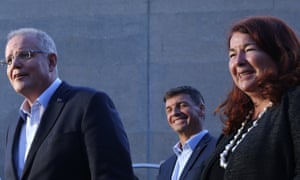“Oh what a tangled web we weave, when first we practise to deceive” — Walter Scott
Last week, environment minister Melissa Price and energy minister Angus Taylor once again hit the airwaves, lying to the public on Australia’s carbon emissions, claiming that emissions are falling.
“Seasonally adjusted, weather normalised” emissions for the September
2018 quarter did fall by a little over 1%. However, this cherry-picked
data point deceptively obfuscates the true message that Australia’s
emissions have risen year on year since Tony Abbott and Greg Hunt
gleefully despatched the carbon pricing mechanism in mid-2014 and
replaced it with the emissions reduction fund (ERF) the next year.Last week, environment minister Melissa Price and energy minister Angus Taylor once again hit the airwaves, lying to the public on Australia’s carbon emissions, claiming that emissions are falling.
Under the ERF, large corporates have been issued credits to change fuel-oil engines for diesel, and diesel engines to gas, even when they would have done so in the normal course of business. Landfill gas generators installed to meet methane emission regulations have received millions of unnecessary credits. In one case a generator was built 13 years before the ERF. Agribusinesses have swapped clearing permits for carbon credits, a legitimate activity, but highly questionable in cases where the permits had been issued just weeks before conversion to credits. And even then, only 20% of the headline 193Mt of emissions reductions have been “delivered”.
As at the 2007 election, voters are ahead of a Coalition government on the need to respond to the climate crisis. Perhaps more so, with extreme summer temperatures, a slew of natural disasters and calls from parts of the community that are increasingly hard to ignore, such as the thousands of students who will strike on 15 March in 38 cities and towns around the country.
Taylor and Price have both repeated Scott Morrison’s claim ad nauseam that we’ll meet our Paris commitments “in a canter”. Yet the brief from their shared department is that we must first resolve a 695 million tonne carbon deficit before we can even limp over the finish line.
The centrepiece of the Orwellian sounding “solution” is nothing more than a simple rebadging of the flawed ERF but with one third the annual funding. The new fund aims to spend $2bn of public money to reduce emissions by 103Mt by 2030. Meanwhile, the Wheatstone and Gorgon LNG projects in Western Australia are on track to emit 203Mt over the same period, at no cost to owner Chrevron, an international company well known for its aversion to contributing to our public coffers.
The Morrison government intends to cancel half the carbon deficit by using “hot air” credits from the Kyoto protocol — credits that don’t relate to emissions we actually saved, but are instead a measure of how far we came under an artificially high emissions threshold we argued for in Kyoto in 1997.
The hard work to receive the hot air credits was in our adroit, but morally questionable, diplomacy during tense negotiations on a very different international agreement in a very different era.
Imagine if a cardiologist made you promise to lose 10 kilograms. Six months later you return having put on an extra two kilos, so now you need to lose 12 kilos. “No problem doc”, you say, “I didn’t put on 10 kilos back in the 1990s, so if you subtract those, I now only need to lose 2 kilos.” You might be able to convince yourself, but your medical team, and your heart, won’t care for your logic.
The key commitment of the Paris agreement is to keep global warming to well below two degrees celsius. The only way to achieve this is to significantly reduce greenhouse gas emissions. No amount of tricky accounting will fool the brutal physics of climate change, or negate the clear warnings of the world’s leading climate scientists that anything above 1.5 degrees will be catastrophic.
Trying to roll over Kyoto credits is not just against the spirit of the agreement, it undermines the collective agreement which is why many countries — including Germany, the Netherlands, and Britain — have ruled them out.
In a carbon constrained global economy, Australia is once again the lucky country. Our boundless plains are windswept and sun-drenched. Extraordinary quantities of clean energy are ours for the taking — to harness for the production of energy intensive materials, to export as hydrogen-based chemicals or even to send to Indonesia and beyond by long distance undersea cables.
The Coalition needs to stop lying on emissions and come back with a credible climate policy that delivers our fair share of global carbon reductions and positions our economy to take full advantage of the opportunities before us.
Maybe the best climate policy right now would be to call an election?
• Simon Holmes à Court is senior adviser to the Climate and Energy College at Melbourne University

No comments:
Post a Comment